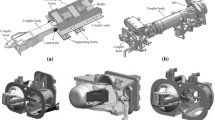Abstract
A heavy-haul train-track coupled model is developed. Taking the emergency braking of the 2×104 t combined train as example, the train longitudinal impulse, the coupler dynamic behaviors and wheel-rail interactions of vehicles distributing in the different positions are analyzed. The results indicate that under the coupler compressing forces, the couplers of middle locomotives may tilt to the free swing limits, which induces the unidirectional tilt of their connected wagon couplers. Consequently, the coupler longitudinal forces produce the lateral components, and then affect the wheel−rail dynamic interaction. The performance of the middle locomotive and their neighboring freight wagons deteriorate significantly, becoming the most dangerous parts in the combined train. The wagons disconnecting with the locomotives can basically keep their couplers to stabilize in the centering positions, even though the maximum coupler longitudinal force acts on it. And its corresponding running safety also has little changes.
Similar content being viewed by others
References
WANG Juan. Influence of coupler draft gears on the safety of heavy haul train under longitudinal stress [D]. Chengdu: Southwest Jiaotong University, 2009. (in Chinese)
CHENG Hai-tao, FANG Ke-juan. Dynamic simulation for working conditions in braking and uniform running of freight cars [J]. Rolling Stock, 1999, 37(11): 9–11. (in Chinese)
ENGLISH G W, MOYNIHAN T W. Causes of accidents and mitigation strategies [R]. Kingston Ontario: TranSys Research Ltd, 2007.
WILSON N, FRIES R, WITTE M. Assessment of safety against derailment using simulations and vehicle acceptance tests: A worldwide comparison of state-of-the-art assessment methods [J]. Vehicle System Dynamics, 2011, 49(7): 1113–1157.
COLE C. Improvements to wagon connection modelling for longitudinal train simulation [C]// Proceedings of Conference on Railway Engineering. Rockhampton: Institution of Engineering, 1998: 187–194.
COLE C, MCCLANACHAN M, SPIRYAGIN M, SUN Y Q. Wagon instability in long trains [J]. Vehicle System Dynamics, 2012, 50(Suppl.): 303–317.
CHOU M, XIA X, KAYSER C. Modelling and model validatioin of heavy-haul trains equipped with electronically controlled pneumatic brake systems [J]. Control Engineering Practice, 2007, 15: 501–509.
NASR A, MOHAMMADI S. The effects of train brake delay time on in-train forces [J]. Proceedings of the Institution of Mechanical Engineers, Part F: Journal of Rail and Rapid Transit, 2010, 224: 523–534.
QI Zhao-hui, HUANG Zhi-hao, KONG Xian-chao. Simulation of longitudinal dynamics of long freight trains in positioning operations [J]. Vehicle System Dynamics, 2012, 50(9): 1409–1433.
AFSHARI A, SPECCHIA S, SHABANA A A. A train air brake force model: Car control unit and numerical results [J]. Proceedings of the Institution of Mechanical Engineers, PartF: Journal of Rail Rapid Transit 2012, 227(1): 38–55.
CHEN D. Derailment risk due to coupler jack-knifing under longitudinal buff force [J]. Proceedings of the Institution of Mechanical Engineers, Part F: Journal of Rail and Rapid Transit, 2010, 224: 483–490.
PUGI L, RINDI A, ERCOLE A G. Preliminary studies concerning the application of different braking arrangements on Italian freight trains [J]. Vehicle System Dynamics, 2011, 49(8): 1339–1365.
ZHANG Z Y, DHANASEKAR M. Dynamics of railway wagons subjected to braking torques on defective tracks [J]. Vehicle System Dynamics, 2012, 50(1): 109–131.
YANG Liang-liang, KANG Yu, LUO Shi-hui. Assessment of the curving performance of heavy haul trains under braking conditions [J]. Journal of Modern Transport, 2015, 23(3): 169–175.
ALLOTA B, CONTI R, MELI E A. Railway vehicle dynamics under degraded adhesion conditions: An innovative HIL architecture for braking test on full-scale roller-rigs [J]. International Journal of Railway Technology, 2014, 2(3): 21–53.
WEI Lei, ZENG Jing, WANG Qun-sheng. Investigation of in-train stability and safety assessment for railway vehicles during braking [J]. Journal of Mechanical Science and Technology, 2016, 30(4): 1507–1525
ZHAI Wan-ming. Vehicle-track coupled dynamics [M]. 4th Edtion, Beijing: Science Press, 2015. (in Chinese)
ZHAI Wan-ming, GAO Jian-ming, LIU Peng-fei. Reducing rail side wear on heavy-haul railway curves based on wheel–rail dynamic interaction [J]. Vehicle System Dynamics, 2014, 52(Suppl.): 440–454.
LIU Peng-fei, ZHAI Wan-ming, WANG Kai-yun. Establishment and verification of three-dimensional dynamic model for heavy-haul train track coupled system [J]. Vehicle System Dynamics, 2016, 54(11): 1511–1537.
LIU Peng-fei, WANG Kai-yun, ZHAI Wan-ming. Dynamics Interaction between heavy-haul locomotive and track under driving conditions [J]. Journal of Southwest Jiaotong University, 2014, 49(1): 15–20. (in Chinese)
WANG Fu-tian. Vehicle system dynamics [M]. Beijing: China Railway Publishing House, 1994. (in Chinese)
MASSA A, STRONATI L, ABOUBAKR A K. Numerical study of the non-inertial systems: application to train coupler systems [J]. Nonlinear Dynamics, 2012, 68: 215–233.
YI Si-rong. Railway engineering [M]. 2nd Edition. Beijing: China Railway Publishing House, 2009. (in Chinese)
Locomotive & Car Research Institute. Experimental research of 20000 t heavy-haul train in Daqin railway line [R]. Beijing: China Academy of Railway Sciences, 2007. (in Chinese)
TAO Qiang, YAO Xiao-pei, WU Pei-yuan, SUN De-huan. Comparative analysis of coupler longitudinal forces for 20000t heavy-haul combined train in braking test of Daqin railway line [C]// Proceedings of 12th Vehicle Brake Sympsium of China Railway Society. Wuxi: China Railway Society, 2009: 40–62.
Author information
Authors and Affiliations
Corresponding author
Additional information
Foundation item: Projects(51605315, 51478399) supported by the National Natural Science Foundation of China; Project(2013BAG20B00) supported by the National Key Technology R&D Program of China; Project(TPL1707) supported by the Open Project Program of the State Key Laboratory of Traction Power, China
Rights and permissions
About this article
Cite this article
Liu, Pf., Wang, Ky. Dynamic performance of heavy-haul combined train applying emergency braking on straight line. J. Cent. South Univ. 24, 1898–1908 (2017). https://doi.org/10.1007/s11771-017-3597-3
Received:
Accepted:
Published:
Issue Date:
DOI: https://doi.org/10.1007/s11771-017-3597-3



